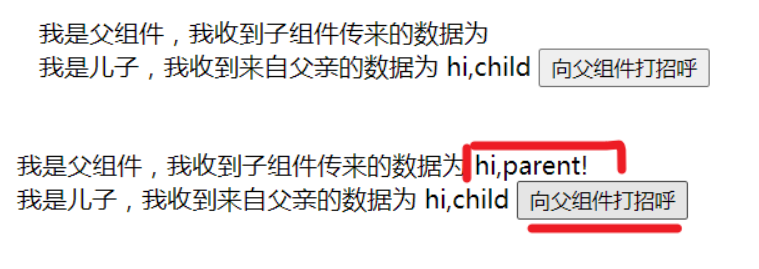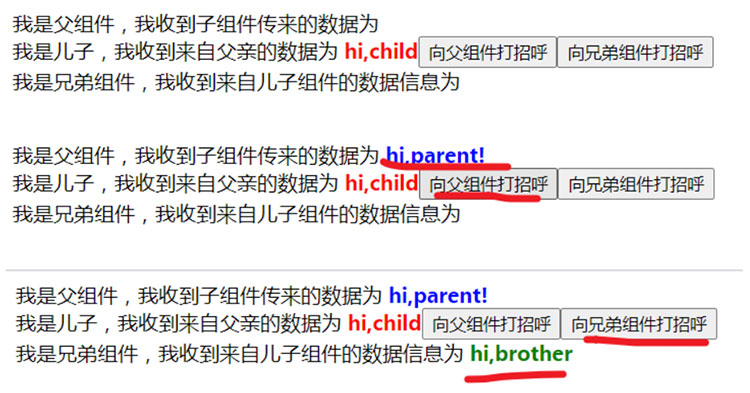Vue组件间通信 Vue怎样实现组件间通信
lovin 人气:01. 父子间通信
最常见的就是父子之间的通信,通信是双向的数据传递。
1.1 父组件 --> 儿子组件
父组件向儿子组件传递数据的方式就是 通过 Prop 向子组件传递数据。
//child.vue
<template>
<div>
我是儿子,我收到来自父亲的数据为 {{value}}
</div>
</template>
<script>
export default {
props:{
value: String
}
}
//App.vue
<template>
<div id="app">
<Child :value="x" />
</div>
</template>
<script>
import Child from './components/Child'
export default {
data(){
return {
x: 'hi,child'
}
},
components:{
Child
}
}
</script>
1.2 儿子组件 --> 父组件
儿子组件向父组件传递数据的方式就是通过子组件内 $emit 触发自定义事件,子组件使用时 v-on 绑定监听自定义事件。
这里的 v-on 事件通信是在子组件使用时作为子组件的事件属性自动进行监听的。
因此儿子组件向父组件传递数据,依赖于子组件使用时的自定义事件属性。
//child.vue
<template>
<div>
我是儿子,我收到来自父亲的数据为 {{value}}
<button @click="sayHi">
向父组件打招呼
</button>
</div>
</template>
<script>
export default {
props:{
value: String
},
methods:{
sayHi(){
this.$emit('sayHi','hi,parent!');
}
}
}
</script>
//App.vue
<template>
<div id="app">
我是父组件,我收到子组件传来的数据为 {{y}}
<Child :value="x" @sayHi="y = $event"/>
</div>
</template>
<script>
import Child from './components/Child'
export default {
data(){
return {
x: 'hi,child',
y: ''
}
},
components:{
Child
}
}
</script>

2. 爷孙间通信
爷孙间通信,可以使用两次 v-on 通信,爷爷爸爸通信,然后爸爸儿子通信。
也可使用下方的任意组件间通信的方式。
3. 任意组件间通信
任意组件间通信就不再区分是 A 向 B 通信,还是 B 向 A 通信,而是通用的方式,谁想发送数据就使用对应的 API 发送数据,谁想要接收什么数据,就使用对应的 API 接收。
任意组件间通信有两种方式,一种是使用 EventBus 发布订阅模式通信,一种是使用 Vuex 通信。
3.1 EventBus
EventBus ,从字面意思理解就是事件公交车,所有触发的事件传递的数据都从前门上车保存到公交车上,然后通过监听对应事件提供的出口让对应的事件数据下车。
EventBus,实际意思是发布和订阅模式,就是谁想把数据传递出去,就要通过触发自定义事件的 API 进行数据的发布;谁需要接收该数据信息的,就通过事件监听的 API 进行数据的监听,一旦检测到监听的数据发布出来,就会接收,这就是数据的订阅。
EventBus 通信方式最重要是搞明白发布和订阅的接口 API,在 Vue 中,Vue 实例有提供两个接口,即 $emit 和 $on ,因此可以新创建一个空的 Vue 实例,来获得这两个接口。
const eventBus = new Vue(); eventBus.$emit(eventName, […args]) //发布事件 eventBus.$on(event, callback) //订阅事件
实例如下:
// eventBus.js import Vue from 'vue' export const eventBus = new Vue();
//child
<template>
<div>
我是儿子,我收到来自父亲的数据为 <strong>{{value}}</strong>
<button @click="sayHi">
向父组件打招呼
</button>
<button @click="sibling">
向兄弟组件打招呼
</button>
</div>
</template>
<script>
import {eventBus} from '../eventBus.js'
export default {
props:{
value: String
},
methods:{
sayHi(){
this.$emit('sayHi','hi,parent!');
},
sibling(){
eventBus.$emit('sibling','hi,brother');
}
}
}
</script>
<style scoped>
strong{
color: red;
}
</style>
//sibling
<template>
<div>
我是兄弟组件,我收到来自儿子组件的数据信息为 <strong>{{x}}</strong>
</div>
</template>
<script>
import {eventBus} from '../eventBus.js'
export default {
data(){
return {
x: ''
}
},
mounted(){
eventBus.$on('sibling', (msg)=>{
this.x = msg;
})
}
}
</script>
<style scoped>
strong{
color: green;
}
</style>
//parent
<template>
<div id="app">
我是父组件,我收到子组件传来的数据为 <strong>{{y}}</strong>
<Child :value="x" @sayHi="y = $event"/>
<Sibling></Sibling>
</div>
</template>
<script>
import Child from './components/Child'
import Sibling from './components/Sibling'
export default {
data(){
return {
x: 'hi,child',
y: ''
}
},
components:{
Child,
Sibling
}
}
</script>
<style scoped>
strong{
color: blue;
}
</style>

关于 EventBus 这部分,可能存在这样一个疑问,既然 Vue 实例中都有 $emit 和 $on,为什么不直接用 this.$emit 触发事件, this.$on 接收事件呢?还非得要额外一个空实例 eventBus = new Vue() 。那是因为,Vue 中每个组件都是一个单独的 Vue 实例,你在这个 Vue 实例中触发该实例的 emit 事件,另外一个实例的 on 事件是接收不到的,不在一辆公交车上,怎么能进行事件通信呢?因此就必须要一个公共的公交车,也就是事件总线。
上述实例中的 eventBus 的使用方法是局部的 eventBus,谁要用到 eventBus 要自己手动引入。也可以将 eventBus 做成全局的,比如挂在 vue 的原型上。
//main.js
import Vue from 'vue'
import App from './App.vue'
Vue.config.productionTip = false
Vue.prototype.$eventBus = new Vue();//添加这句,一定要在下方的 new Vue 前。
new Vue({
render: h => h(App),
}).$mount('#app')
//child
sibling(){
this.$eventBus.$emit('sibling','hi,brother');
}
//sibling
mounted(){
this.$eventBus.$on('sibling', (msg)=>{
this.x = msg;
})
}
除了上述的添加属性到 Vue 原型的方式外,还可以使用 Object.defineProperty() 为 Vue 原型添加属性。
import Vue from 'vue'
import App from './App.vue'
Vue.config.productionTip = false
let eventBus = new Vue()
Object.defineProperty(Vue.prototype,'$eventBus',{
get(){
return eventBus
}
})
new Vue({
render: h => h(App),
}).$mount('#app')
3.2 Vuex
Vue 组件间的通信也可使用专门为 vue.js 应用程序开发的状态管理模式:Vuex。Vuex 的使用比较复杂,详细可见 Vuex 博客。Vuex 适用于大型的复杂的 Vue 项目的状态管理。对于一些中小型的应用程序,可以根据 Vuex 的原理自定义 store 模式进行状态管理,vue 自定义状态管理,可详见 Vue 简单状态管理—store模式 博客。
无论是 Vuex 还是 自定义 store模式 ,其实现组件间通信的原理都是通过共享数据的方式实现的。组件间使用相同的数据源,当一个组件改变数据时,另一个组件依赖的数据源也就改变了。
加载全部内容